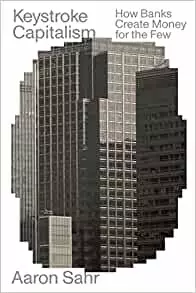Keystroke Capitalism
Aaron Sahr
"Keystroke Capitalism: How Banks Create Money for the Few", Aaron Sahr
Aaron Sahr offers a rich discourse on the huge growth of financial markets in modern economies and the implication for inequality. We face a ‘trinity of growing private wealth, mounting debt, and rising inequality’ (p8). We need to understand ‘the process of financialization’ (p7). Profits earned in the burgeoning financial sector far exceed those in productive industry (p13). Consumer household debt has grown hugely (p18,36). The welfare state is increasingly funded by borrowing (p100). Trade in financial derivatives has seen a ‘meteoric rise’ (p27). Real wages and the labour share of GDP has declined (p30,36).
To explain this Sahr asks ‘how do banks create money?’ (p55). Having explained the history of ‘fractional reserve banking’ (p58), Sahr points out that commercial banks do not lend money from the savings deposits of their customer, or according to some multiple of their central bank reserves, but purely on the demonstrable ability of the lender to repay the loan (p65, 109). Commercial banks create money from thin air (p66-68). This is what Sahr calls a ‘para-economic privilege’ (p68). He then asks ‘who are the keystroke rentiers?’ (p78). He quotes Adair Turner that 85% of bank generated credit has been used to purchase existing assets (p80). This has caused huge asset price inflation. 80% of the increase in the value of housing from 1950 to 2012 has been in their land content. Companies like Apple have bought their own shares back to inflate share prices (p84). Commercial banks create money at zero marginal cost and then earn both interest and seigniorage (p90,92).
Sahr writes that there is no legitimacy to the banks’ privilege to create money (p102). But he's sceptical of the sovereign money movement’s proposals to essentially nationalise the privilege of money creation, worrying that this would yield a less dynamic, bureaucratic system (p117,120). He speculates on a ‘mix of private and public money creation subject to suitable restrictions’ and ‘the monetary financing of the public sector’ (p123), given that ‘public authorities everywhere plead scarcity of funds amid austerity policies’ (p125). He rather peters out with a call to democratise keystroke capitalism, or at least to ‘give it a try’. (p125).
Sahr’s book is great as far as it goes. More analysis is needed to show more clearly exactly how and to what extent the burgeoning financial sector affects the real economy. Some financial ‘casino’ markets might be relatively sealed off from the real economy, whilst others have dire effects. The claim that financialization drives up asset prices must have some limits since asset prices can’t be driven up forever. We, therefore, need a more comprehensive theory of asset prices. The Swiss central bank opposed the referendum proposal for sovereign money because it pointed out that it lacks the resource or expertise to determine private sector business and household loans. Sahr’s mixed private and public money creation proposal is more practicable.
What Sahr doesn’t examine is government money creation for debt-funded government expenditure. Orthodoxy insists that when central banks create money for government expenditure, they accept a corresponding debt in a double-entry accounting system. This leads to national government debts well in excess of GDP, or in the case of Japan >250% of GDP, which is clearly unrepayable and delusory. But they do impose financing costs, and they do act as severe limits on further government expenditure, generating socially damaging austerity policy. Just as commercial banks can create money from nothing, so can the government through its central bank. Moreover, in the government/central bank case there is no definitional or practical need to account this as debt. Debt-free sovereign money is theoretically possible as an alternative to ever increasing national debt. It is also practically possible as has been demonstrated in several economies’ furlough schemes during the Covid pandemic. In the UK, 3m people received £24K costing a total of £69bn which was totally funded by the Bank of England buying government debt. Since the government owns the Bank of England, this is now not debt at all. Sahr also omits a major critique of central bank purchase of government debt. In most jurisdictions, the central bank is prohibited from purchasing government debt in the primary market, so has to purchase in the secondary market. This gives an immense risk free profit margin and portfolio value gain to stockbrokers, pension funds, insurance companies, and high wealth individuals. This is a major scandal of financialization and should be corrected, either by the central bank having direct access to the primary market or simply being enabled to issue debt-free sovereign money.
Debt-free sovereign money creation is a real option to fund government programs, including proposals for a basic income to replace the crippling household debt Sahr identifies, and to feed necessary income to households to replace labour income lost due to technology and automation.
The book is available here.
Geoff Crocker
Editor ‘The Case for Universal Basic Income'
www.ubi.org

